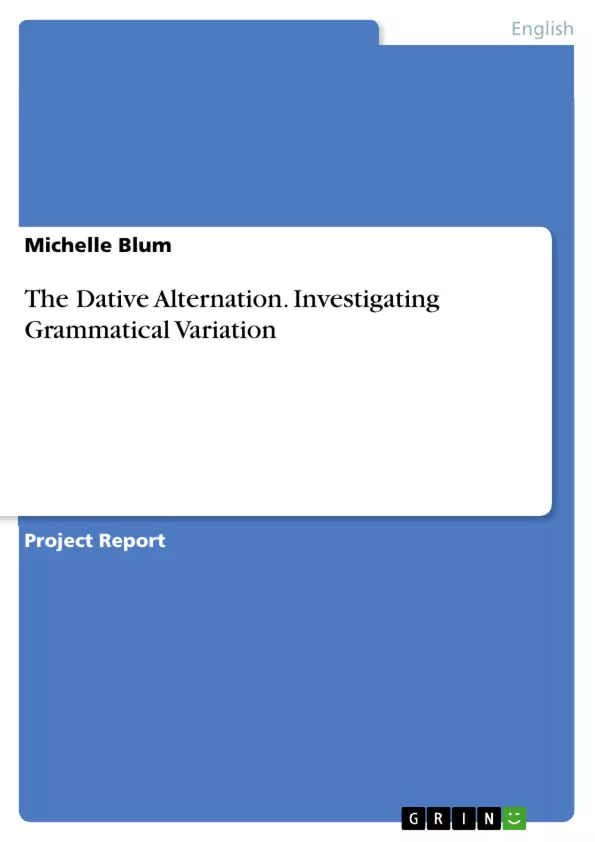The phenomenon under investigation was the dative alternation, i.e. the factors influencing the choice between the NP/noun phrase dative ("I give him the book") and the PP/prepositional phrase dative ("I give the book to him"). It is generally assumed, that factors holding an influence over the dative choice are, among others, the syntactic complexity/length of the indirect object and the verbs used.
In order to find out which factor is more influential in the choice, both factors were considered in the study. Some verbs, like give, promise, lend and mail, have a tendency towards the usage with the NP dative - that means that they would not be used with the PP dative, and this would thus mean that the NP dative would be used more often when these verbs occur - if the verb choice influences the dative form more than the syntactic complexity, that is.
Inhaltsverzeichnis (Table of Contents)
- The phenomenon under investigation
- Revised project outline
- Research questions
- Hypotheses
- Outline of the experiment
- Rational
- Items/Fillers
- The Questionnaire
- Data summary
- Type and quantity of data
- Did you have problems when obtaining the data?
- How did you deal with those problems?
- Methods and Results
- How did you analyze your data?
- What are your results?
- Reference to the hypothesis
- Short project summary
- Introduction
- Methodology
- Results
- Discussion
- References
Zielsetzung und Themenschwerpunkte (Objectives and Key Themes)
This research project aims to investigate the influence of probabilistic grammatical constraints, specifically syntactic complexity and verb choice, on the dative alternation in English as a second language. The focus is on German learners of English and their proficiency levels.
- Dative alternation and its factors (syntactic complexity, verb choice)
- Influence of proficiency levels on dative construction choice
- Probabilistic grammatical constraints in language acquisition
- Comparison of NP dative and PP dative constructions
- Analysis of dative alternation in German-English interlanguage
Zusammenfassung der Kapitel (Chapter Summaries)
- The phenomenon under investigation: This chapter defines the dative alternation, outlining the NP dative and PP dative constructions. It discusses the factors believed to influence the choice between these forms, specifically syntactic complexity and verb type. Examples of verbs and indirect object length are provided to illustrate the concept.
- Revised project outline: This chapter outlines the research questions and hypotheses guiding the study. It also details the experimental design, including the rationale for using a questionnaire and the specific conditions, items, and factors included in the experiment.
- The Questionnaire: This chapter describes the questionnaire used for data collection, outlining the types of questions and the participant groups targeted.
- Data summary: This chapter details the types and quantity of data collected, addressing potential problems encountered during data gathering and the methods used to resolve them.
- Methods and Results: This chapter explains the data analysis methods used and presents the key results obtained. It also references the hypotheses established earlier and discusses their confirmation or refutation based on the findings.
Schlüsselwörter (Keywords)
The primary keywords and focus topics of this work include dative alternation, syntactic complexity, verb choice, proficiency levels, probabilistic grammatical constraints, NP dative, PP dative, German-English interlanguage, and second language acquisition.
- Arbeit zitieren
- Michelle Blum (Autor:in), 2019, The Dative Alternation. Investigating Grammatical Variation, München, GRIN Verlag, https://www.grin.com/document/1128286



